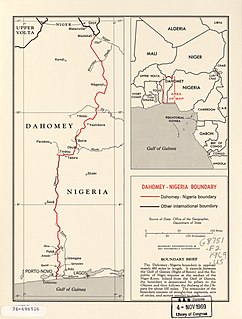
Frederick John Dealtry Lugard, 1st Baron Lugard,, known as Sir Frederick Lugard between 1901 and 1928, was a British soldier, mercenary, explorer of Africa and colonial administrator. He was Governor of Hong Kong (1907–1912), the last Governor of the Southern Nigeria Protectorate (1912–1914), the first High Commissioner (1900–1906) and last Governor (1912–1914) of the Northern Nigeria Protectorate and the first Governor-General of Nigeria (1914–1919).

The flag of Nigeria was designed in 1959 and first officially hoisted on 1 October 1960. The flag has three vertical bands of green, white, green. The two green stripes represent Nigeria's natural wealth, while the white band represents peace.

The city of Warri is an oil hub in South-South Nigeria and houses an annex of the Delta State Government House. It served as the colonial capital of the then Warri Province. It shares boundaries with Ughelli/Agbarho, Sapele, Okpe, Udu and Uvwie although most of these places, notably Udu, Okpe and Uvwie, have been integrated to the larger cosmopolitan Warri. Osubi houses an airport that serves the city. Effurun serves as the gateway to and the economic nerve of the city.

Northern Nigeria was a British protectorate which lasted from 1900 until 1914 and covered the northern part of what is now Nigeria.

Southern Nigeria was a British protectorate in the coastal areas of modern-day Nigeria formed in 1900 from the union of the Niger Coast Protectorate with territories chartered by the Royal Niger Company below Lokoja on the Niger River.

The coat of arms of Nigeria consists of a black shield with a wavy white pall, symbolizing the meeting of the Niger and Benue Rivers at Lokoja. The black shield represents Nigeria's fertile soil, while the two supporting horses or chargers on each side represent dignity. The eagle represents strength, while the green and white bands on the top of the shield represent the rich soil.

Colonial Nigeria was the era in the History of Nigeria when the region of West Africa was ruled by Great Britain in from the mid-19th century up till 1960 at her independence. British influence in the region began with the prohibition of slave trade to British subjects in 1807. Britain annexed Lagos in 1861 and established the Oil River Protectorate in 1884. British influence in the Niger area increased gradually over the 19th century, but Britain did not effectively occupy the area until 1885. Other European powers acknowledged Britain's dominance over the area in the 1885 Berlin Conference.
Henry Carr was a Nigerian educator and administrator. He was one of the most prominent West Africans in the late nineteenth and early twentieth century and was a member of the legislative council in Lagos from 1918–1924.

This is a survey of the postage stamps and postal history of the Southern Nigeria Protectorate.
Chief Christopher Alexander Sapara Williams was the first indigenous Nigerian lawyer, called to the English bar on 17 November 1879. In addition to his legal practice, he came to play an influential role in the politics of Nigeria during the colonial era. He held the chieftaincy title of the Lodifi of Ilesha.

Lagos Colony was a British colonial possession centred on the port of Lagos in what is now southern Nigeria. Lagos was annexed on 6 August 1861 under the threat of force by Commander Beddingfield of HMS Prometheus who was accompanied by the Acting British Consul, William McCoskry. Oba Dosunmu of Lagos resisted the cession for 11 days while facing the threat of violence on Lagos and its people, but capitulated and signed the Lagos Treaty of Cession. Lagos was declared a colony on 5 March 1862. By 1872 Lagos was a cosmopolitan trading center with a population over 60,000. In the aftermath of prolonged wars between the mainland Yoruba states, the colony established a protectorate over most of Yorubaland between 1890 and 1897. The colony and protectorate were incorporated into Southern Nigeria in February 1906, and Lagos became the capital of the protectorate of Nigeria in January 1914. Since then, Lagos has grown to become the largest city in West Africa, with an estimated metropolitan population of over 9,000,000 as of 2011.

Sir Walter Egerton, had a long career in the administration of the British Empire, holding senior positions which included the Governorships of Lagos Colony (1904–1906), Southern Nigeria (1906–1912), and British Guiana (1912–1917).

The Government Gazette of the Protectorate of Southern Nigeria was the government gazette for the Protectorate of Southern Nigeria. It was published at Old Calabar between 1900 and 1906.

The Southern Nigeria Government Gazette was the government gazette for the Colony and Protectorate of Southern Nigeria. It was published at Lagos between 1907 and 1913.

The Nigeria Gazette was the government gazette for the Colony and Protectorate of Nigeria. It was published at Lagos between 1914 and 1954.
Federation of Nigeria Official Gazette was the government gazette for the Colony and Protectorate of Nigeria and of the Federal Republic of Nigeria for the first three years of its existence (1960-63). It was published at Lagos.
Sir Frederick Seton James, was a British colonial administrator. He was the Colonial Secretary of the Straits Settlements (1916–1924) and Governor of the Windward Islands (1924–1930).

The Chad–Nigeria border is 85 km in length and consists of a single diagonal line running NW to SE from the tripoint with Niger in the north to the tripoint with Cameroon in the south.

The Niger–Nigeria border is 1,608 km in length and runs from the tripoint with Benin in the west to the tripoint with Chad in the east.

The Benin-Nigeria border is 809 km in length and runs from the tripoint with Niger in the north down to the Bight of Benin in the south.













